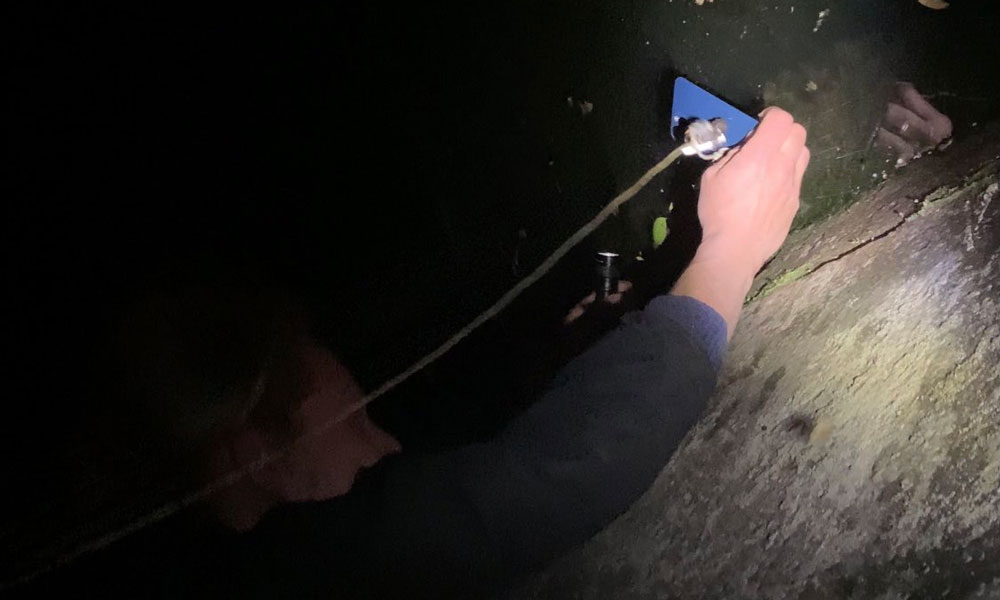This iPhone 12 Pro Was Recovered from the Bottom of a Canal Thanks to Apple’s MagSafe Technology
 Credit: Frederik Riedel / Twitter
Credit: Frederik Riedel / Twitter
Toggle Dark Mode
Apple’s MagSafe connector isn’t just for charging your iPhone and attaching cases — it turns out it can also be a big help when you need to fish your device out of a lake or canal, as one app developer in Germany recently discovered.
As reported by AppleInsider, a friend of Frogg developer Frederik Riedel dropped his iPhone 12 Pro in the canal in Berlin on Saturday night. While the canal is only three feet deep at that point, the iPhone quickly disappeared out of sight into the mud, and Riedel’s friend waded in but was unable to find it — although he did come up with a Nintendo Switch instead.
So, the duo decided to take a different approach, realizing that since the iPhone 12 Pro has a big ring of magnets on the back, it would presumably be easy to retrieve by building a “magnetic fishing rod.”
Basically, Riedel took a normal fishing rod and line, attached a magnet to the end, and then began dredging the bottom of the canal until his iPhone popped up out of the muck.
The entire process apparently took several hours, as it was 3 a.m. before the iPhone 12 Pro surfaced, although when it did come back up it was working fine, and even still had an almost full battery despite being submerged for so long.
Of course, the resiliency of the iPhone 12 Pro shouldn’t be all that surprising, as actual lab tests have shown it can withstand a lot more than simply a relatively brief dunk in a canal. In fact, we’ve seen some surprising survival stories from its predecessor, with iPhone 11 models found in working order after dunks ranging from several weeks at the bottom of a Disney lagoon to six months in a frigid Canadian lake.
So with such great results from iPhone 11 owners, it’s fair to say that iPhone 12 users should feel even more secure, as Apple promises water resistance of up to 30 minutes in up to 20 feet of water, as opposed to the five-foot submersion rating of the iPhone 11.
According to Riedel, the Nintendo Switch that they found didn’t fare nearly as well — it was essentially non-functional, although it’s also unclear how long it had been down there for.
While Riedel credits Apple’s MagSafe technology with helping to rescue the iPhone 12 Pro in question, it’s unclear how much difference this would have made. Earlier this year, Canada’s CTV News reported on another iPhone that took a dive into a cold lake in Saskatchewan and was similarly retrieved using a fish finder to locate it and a magnet to bring it back up to the surface.
In this case, the iPhone owner in question, Angie Carriere, was out on an ice fishing trip celebrating her fiftieth birthday at Waskesiu Lake, Saskatchewan, when a gust of wind caused her to drop her iPhone into the lake. It took 30 days and three separate trips before she was able to retrieve the device, and was surprised to find it was still in working order even after all that time in the cold.
It’s also worth adding that Apple’s normal recommended operating temperatures for any recent iPhone model are between 0° and 35° C (32° to 95° F), although an iPhone can be stored in temperatures between -20º and 45º C (-4º to 113º F). Of course, as cold as the lake was — the surface was clearly frozen — the water underneath obviously had to be above 32° F, and therefore well within the range of the iPhone’s operating temperatures.
While the CTV News report doesn’t specifically mention the model of iPhone, it’s clearly an iPhone 11 Pro, which of course doesn’t include MagSafe. However, Carriere also appeared to be using a fairly substantial magnet in her retrieval operation.
It’s safe to say that the MagSafe ring in an iPhone 12 should definitely help to make a stronger magnetic connection. It’s even possible that an iPhone 12 owner might be able to retrieve their device even without another magnet handy, as the magnetic ring will naturally attach to any ferrous metal placed up against it. In this case, however, the magnetic force likely wouldn’t be strong enough to overcome the weight of the actual iPhone.






